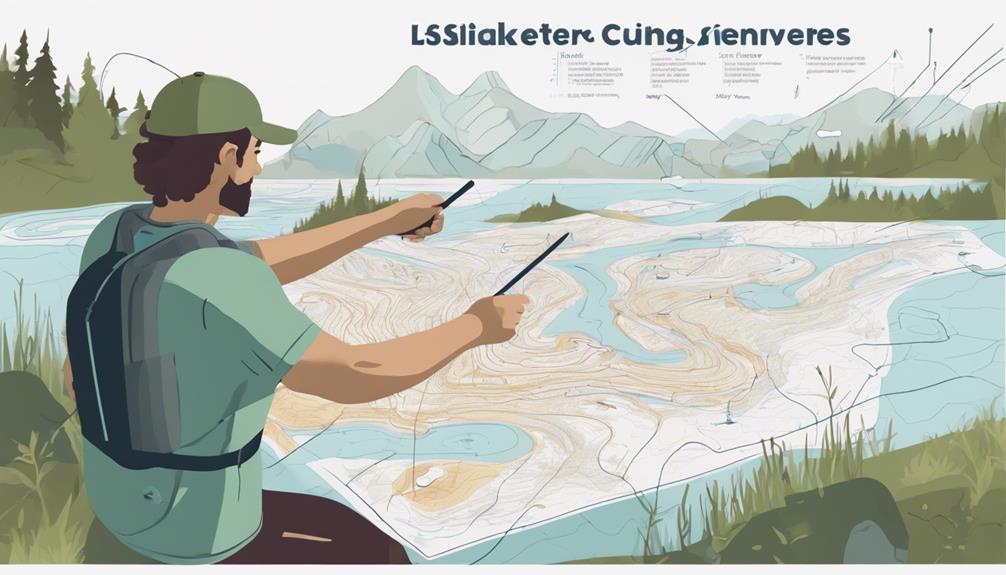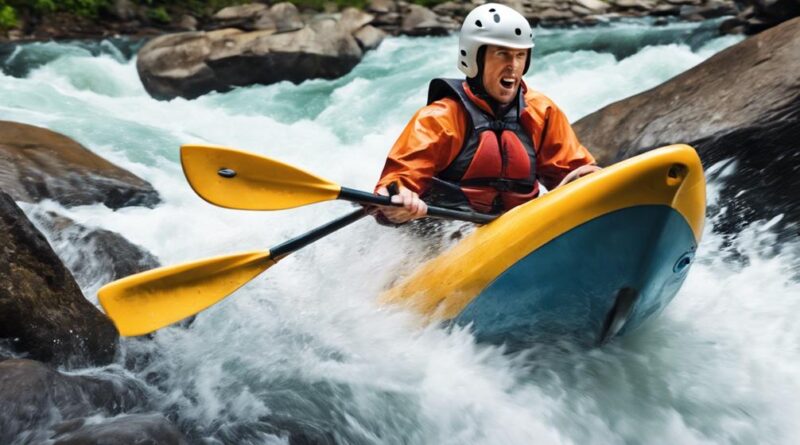Essential Training Tips for River Kayaking Adventures
Imagine yourself gliding through swift currents, surrounded by the serene beauty of nature while navigating the twists and turns of a river.
As you prepare for your river kayaking adventure, mastering essential training tips is crucial for a safe and enjoyable experience. From understanding river classifications to practicing emergency rescue procedures, each aspect plays a vital role in ensuring your skills are finely tuned for the challenges that lie ahead.
Stay tuned to discover key insights that will enhance your river kayaking expertise.
Understanding River Classifications
When navigating rivers for kayaking, understanding river classifications is crucial for your safety and enjoyment. River classifications range from Class I (easy) to Class VI (extremely dangerous), denoting the level of difficulty and danger. Before setting out, ensure you have the necessary river gear essentials. Starting with easier Class I or II rivers is ideal for beginners to build confidence and skill progression. As you gain experience, you can gradually tackle more challenging waters.
To truly understand river classifications, it's essential to grasp water flow dynamics and hazard assessment. Water flow dynamics refer to how the river moves, including rapids, eddies, and currents. Knowing these dynamics helps you navigate effectively and anticipate obstacles. Hazard assessment involves identifying potential dangers in the river, such as submerged rocks, strainers, and strong currents. By recognizing these hazards, you can plan your route strategically and avoid risky situations.
As you venture into different river classifications, always prioritize safety. Check the water levels, weather conditions, and river reports before heading out. Continuously work on improving your kayaking skills and knowledge of river environments. Remember, mastering river classifications takes time and experience, so start slow, stay alert, and enjoy the adventure responsibly.
Mastering Paddling Techniques
To excel in river kayaking, mastering paddling techniques is essential for efficiency and control on the water. Proper posture and efficient strokes are crucial elements to focus on when aiming to enhance your paddling skills.
- Proper Posture: Maintaining the right posture while kayaking is fundamental for both performance and safety. Sit upright, with your back straight and your knees slightly bent. Engage your core muscles to support your movements and prevent strain on your lower back.
- Efficient Strokes: Learning how to execute efficient paddle strokes won't only help you maneuver more effectively but also conserve your energy for longer trips. Practice different types of strokes, such as the forward stroke, sweep stroke, and draw stroke, to have a versatile set of skills to tackle various river conditions.
- Paddle Blade Angle: Pay attention to the angle of your paddle blade in the water. The blade should be fully submerged and perpendicular to the water surface to maximize the power and efficiency of each stroke. Experiment with different angles to find what works best for you in different situations.
Learning River Safety Practices
Start by familiarizing yourself with essential river safety practices to ensure a secure and enjoyable kayaking experience. Safety gear is crucial when kayaking on rivers. Always wear a properly fitted life jacket to stay afloat in case of a capsize. Additionally, consider a helmet to protect your head from potential impacts with rocks or obstacles in the river. Proper attire is also essential for river kayaking. Opt for quick-drying clothing that provides sun protection and allows for freedom of movement. Water shoes with good grip are important to prevent slipping on wet rocks or surfaces.
Before heading out, make sure you're familiar with the river you'll be kayaking on. Check the water levels, flow speed, and any potential hazards such as rapids or low-hanging branches. It's also wise to inform someone of your planned route and expected return time for safety purposes.
In case of an emergency, always carry a whistle or other signaling device to attract attention. Knowing basic first aid skills can also be valuable in unexpected situations. Remember to stay calm and assess the situation carefully.
Practicing Eskimo Rolling
Consider incorporating the use of a practice pool to enhance your skills in mastering the Eskimo roll technique. This controlled environment allows you to focus solely on refining your technique without the distractions of river currents or obstacles.
Tips for Practicing Eskimo Rolling:
- Practice Consistency, Technique: Regular practice is key to mastering the Eskimo roll. Focus on the proper technique each time you practice to build muscle memory and improve your chances of success in real river scenarios.
- Develop Confidence: Building confidence in your ability to execute the Eskimo roll is crucial. The more you practice and see improvement, the more confident you'll become in your skills on the water.
- Improve Balance: Achieving balance while performing the Eskimo roll is essential. Practice maintaining a stable and centered position in the kayak throughout the roll to increase your chances of a successful recovery.
Building Endurance and Strength
Enhance your river kayaking skills by focusing on gradually increasing your endurance and strength levels. Proper nutrition plays a crucial role in supporting your training efforts. Make sure to fuel your body with a balanced diet rich in carbohydrates for energy, proteins for muscle repair, and healthy fats for sustained endurance. Hydration is also key, so drink plenty of water before, during, and after your workouts to stay hydrated and perform at your best.
In addition to a good diet, incorporating cross-training exercises into your routine can help you build the necessary strength for river kayaking. Activities like swimming, cycling, and weight training can target different muscle groups, improving overall strength and endurance. Aim to mix up your workouts to prevent plateauing and keep your body challenged.
To boost your endurance, consider adding cardio exercises such as running or rowing to your regimen. These activities can help increase your cardiovascular fitness, allowing you to paddle longer and more effectively on the river. Remember to listen to your body and gradually increase the intensity and duration of your workouts to avoid overexertion and injuries.
Navigating Rapids Effectively
When navigating rapids effectively while river kayaking, maintain a strong and steady paddle stroke to maneuver through the turbulent waters with control and precision. Rapid response is crucial in swiftly adjusting to the changing dynamics of the rapids, ensuring you stay on course and avoid potential hazards.
Here are some key points to consider for mastering rapids:
- Stay Focused: Keep your eyes on the route ahead and anticipate the best line to follow through the rapids.
- Use Proper Body Positioning: Lean into the rapids and use your body weight to help steer the kayak in the desired direction.
- Employ Whitewater Strategy: Understand the flow of the water and identify eddies or calm spots where you can rest and plan your next move.
Implementing a whitewater strategy involves analyzing the current and planning your route accordingly. By swiftly adapting to the rapid response required, you can navigate through challenging sections with confidence. Remember, practice makes perfect when it comes to mastering the art of navigating rapids effectively.
Understanding Hydrology Basics

To understand the basics of hydrology, focus on how water moves and interacts with its environment. Water dynamics play a crucial role in river kayaking, as they determine the behavior of river currents. Before embarking on your kayaking adventure, familiarize yourself with the flow rate of the river you plan to paddle on. The flow rate indicates the speed at which the water is moving and can vary depending on factors such as recent rainfall or dam releases. Understanding the flow rate will help you anticipate the intensity of the river currents you might encounter.
Moreover, it's essential to be aware of different river features that are shaped by water dynamics. River features such as eddies, rapids, and hydraulic jumps can present both challenges and opportunities for kayakers. Eddies are areas of calm water often found behind obstacles like rocks, providing paddlers with a chance to rest or change course. Rapids, on the other hand, are sections of fast-flowing, turbulent water that require skillful navigation. Hydraulic jumps occur when water flows over an obstruction, creating a powerful recirculating current.
Emergency Rescue Procedures
Understanding the dynamics of water in river kayaking, knowing how to navigate various river features, is crucial for your safety and the safety of others. When engaging in this thrilling adventure, it's essential to be prepared for emergencies.
Here are some key emergency rescue procedures to keep in mind:
- Swiftwater rescue: In the event of someone getting caught in fast-flowing water, swiftwater rescue techniques are vital. Training in swiftwater rescue can help you assist others or yourself in challenging situations where the water current is strong.
- Throw bags: Throw bags are compact bags with a rope inside that are used to quickly throw a rescue line to someone in the water. These bags can be a lifesaver in situations where reaching the person in distress by hand isn't possible or safe.
- Stay calm and communicate: During any rescue operation, it's crucial to stay calm and communicate effectively with others involved. Clear communication can help coordinate rescue efforts and ensure everyone's safety.
Frequently Asked Questions
What Are Some Key Considerations for Choosing the Right Kayak for River Kayaking Adventures?
When selecting a kayak for river kayaking, focus on stability and weight distribution. These factors influence how well you can navigate the water.
Also, consider paddle technique and safety precautions. Proper equipment ensures a successful adventure.
How Can I Prevent Muscle Fatigue and Soreness During Long River Kayaking Trips?
To prevent muscle fatigue and soreness during long river kayaking trips, make sure you focus on proper hydration and regular stretching. These will help keep your muscles loose and reduce the chances of cramping.
After your adventure, consider muscle recovery techniques like gentle massage to help relax tight muscles.
Stay proactive in caring for your body to ensure a more enjoyable and pain-free kayaking experience.
Are There Any Specific Gear or Equipment Recommendations for River Kayaking in Different Weather Conditions?
When kayaking in different weather conditions, it's essential to have proper gear.
Waterproof clothing is crucial to keep you dry and comfortable.
Additionally, safety precautions like wearing a life jacket at all times and having a whistle for emergencies are important.
Make sure to check the weather forecast before heading out and adjust your gear accordingly.
Stay safe and enjoy your kayaking adventures in any weather!
What Are Some Tips for Packing and Organizing Gear Efficiently for Multi-Day River Kayaking Excursions?
When prepping for multi-day river kayaking trips, start by packing essentials like food, water, shelter, and safety gear.
Organize your items into dry bags or waterproof containers for easy access and protection.
Consider gear maintenance like checking for leaks in your kayak and packing repair hacks like duct tape or a patch kit.
Efficient packing and organization will make your excursion smoother and more enjoyable.
How Can I Best Prepare for Unexpected Challenges or Obstacles While Kayaking on a River?
To best prepare for unexpected challenges while kayaking on a river, focus on emergency preparedness and river navigation. Stay alert for obstacles and strong currents.
Develop rapid response and problem-solving techniques. Practice self-rescue maneuvers and learn to read the river for potential hazards.
Always carry essential safety gear like a whistle, first aid kit, and communication device. Stay calm, assess situations quickly, and adapt your paddling technique to navigate challenges effectively.
Conclusion
Now that you've learned the essential training tips for river kayaking adventures, you're ready to tackle any challenge the water may throw your way. Remember to practice your paddling techniques, stay safe on the river, and build your endurance and strength.
With these skills in your arsenal, you'll be able to navigate rapids effectively and handle any emergency rescue situation that may arise. Get out on the water and enjoy your kayaking adventures!
